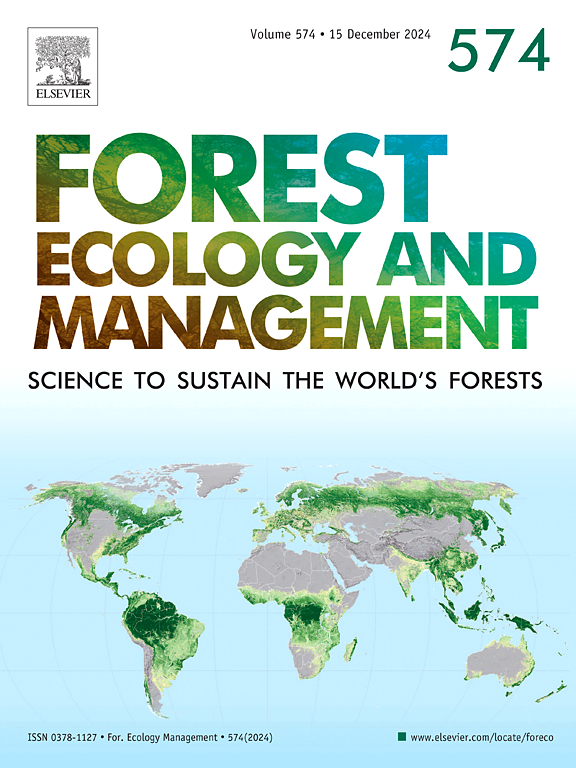严重野火后的植树结果取决于气候、竞争和优先次序
IF 3.7
2区 农林科学
Q1 FORESTRY
引用次数: 0
摘要
随着北美西部针叶林烧毁面积和火灾严重程度的急剧增加,对火灾后重新植树的需求大大超出了土地管理者的能力。尽管植树对许多地区的森林恢复非常重要,但环境变化和植树时机如何影响植树成功率(相对于被动的自然树木再生),以及如何通过在正确的时间集中在正确的地点优化有限的植树资源,这些问题仍不清楚。为了填补这一空白,我们调查了加利福尼亚内华达山脉针叶混交林中五次火灾的补种成功率,这些森林在强烈野火后部分补种了针叶树种。我们选择的这些火场在环境条件(温度、海拔、其他地形对比)和种植时间上都有很大差异,同时在火后管理上尽可能保持一致。在每次火灾中,我们都会在已种植区和附近未种植区(共 182 个小区)随机选取 400 平方米的圆形小区进行调查,按树种统计树苗数量,并统计灌木覆盖率和其他环境变量。通过混合模型分析数据,我们发现在较热、较干燥的地点,被动的自然再生能力较弱(50 株/公顷),而在这些地点,主动植树可以促进森林恢复(最多可达 200%)。我们还发现,植树的时机很重要,但时机的重要性取决于灌木的竞争程度。在灌木竞争激烈的地方,如果在火灾后的第二年植树,植树的成功率要高得多,而在火灾后的第二年植树通常是植树的最佳时机。相反,在灌木竞争较弱的地方,推迟植树,直到一些灌木成活,可以促进树苗的存活,这可能是因为灌木可以为树苗提供庇护,使其免受恶劣环境的影响。我们还发现,植树与更高比例的松树幼苗密切相关,尽管在火灾后植树的时间较晚时,这种积极的植树效应较弱,而且在灌木覆盖率和灌木高度较高的情况下,植树效应被抵消。本文章由计算机程序翻译,如有差异,请以英文原文为准。
Tree planting outcomes after severe wildfire depend on climate, competition, and priority
With dramatic increases in both area burned and fire severity in Western North American conifer forests, the demand for postfire replanting greatly exceeds land managers’ capacity. Despite the importance of tree planting for forest recovery in many areas, it remains unclear how environmental variation and planting timing affect tree planting success relative to passive natural tree regeneration, or how to optimize limited planting resources by focusing on the right places at the right time. To address this gap, we surveyed replanting success across five fires in California Sierra Nevada mixed conifer forest that had been partially replanted with conifer species after intense wildfire. We selected these fires to contain substantial variation in environmental conditions (temperature, elevation, other topographic contrasts) and planting timing, while being as consistent as possible in postfire management. At each fire, we surveyed randomly located 400 m2 circular plots in planted and nearby unplanted areas (total 182 plots), counting seedlings by species as well as shrub cover and other environmental variables. Using mixed models to analyze the data, we found that passive natural regeneration is weaker (<50 seedlings/ha) in hotter, drier sites and that active tree planting can provide a boost (up to 200 %) to forest recovery in these sites. We also found that the timing of tree planting matters, but that the importance of timing depends on the level of competition from shrubs. In places where shrub competition is intense, tree planting is much more successful if planting occurs the year immediately following a fire, the soonest that it is usually practical to plant. In contrast, in places where shrub competition is weaker, delaying tree planting until some shrubs establish can facilitate tree seedling survival, perhaps because shrubs provide shelter from harsh conditions. We also found that tree planting was strongly associated with a higher proportion of pine seedlings, although this positive planting effect was weaker when planting happened later after fire, and was cancelled out at higher levels of shrub cover and shrub height.
求助全文
通过发布文献求助,成功后即可免费获取论文全文。
去求助
来源期刊

Forest Ecology and Management
农林科学-林学
CiteScore
7.50
自引率
10.80%
发文量
665
审稿时长
39 days
期刊介绍:
Forest Ecology and Management publishes scientific articles linking forest ecology with forest management, focusing on the application of biological, ecological and social knowledge to the management and conservation of plantations and natural forests. The scope of the journal includes all forest ecosystems of the world.
A peer-review process ensures the quality and international interest of the manuscripts accepted for publication. The journal encourages communication between scientists in disparate fields who share a common interest in ecology and forest management, bridging the gap between research workers and forest managers.
We encourage submission of papers that will have the strongest interest and value to the Journal''s international readership. Some key features of papers with strong interest include:
1. Clear connections between the ecology and management of forests;
2. Novel ideas or approaches to important challenges in forest ecology and management;
3. Studies that address a population of interest beyond the scale of single research sites, Three key points in the design of forest experiments, Forest Ecology and Management 255 (2008) 2022-2023);
4. Review Articles on timely, important topics. Authors are welcome to contact one of the editors to discuss the suitability of a potential review manuscript.
The Journal encourages proposals for special issues examining important areas of forest ecology and management. Potential guest editors should contact any of the Editors to begin discussions about topics, potential papers, and other details.
 求助内容:
求助内容: 应助结果提醒方式:
应助结果提醒方式:


